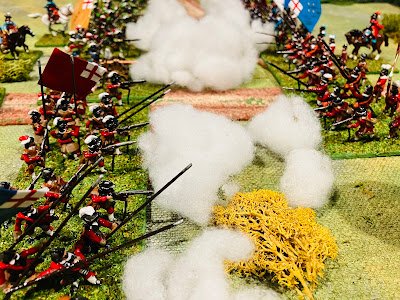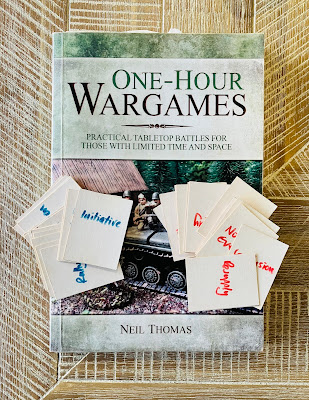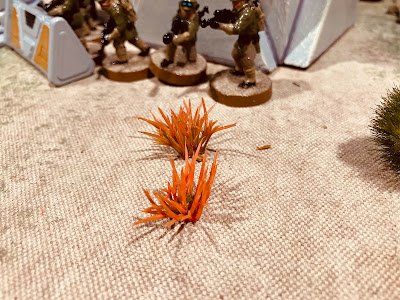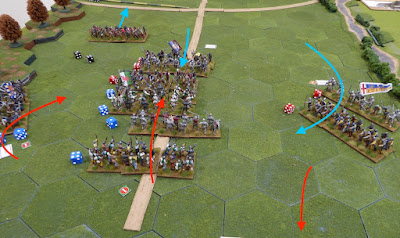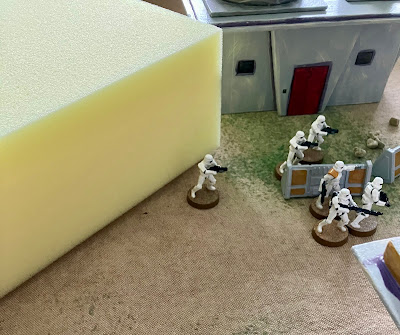This is an English Civil War battle report following on from the previous post where some pre-game actions were tested to influence an army's deployment, composition, and also its readiness. While also helping develop the game’s narrative.
 |
| Infantry engage in the centre. |
The tabletop layout was decided by terrain cards drawn from deck. A little bit more on using terrain cards can be found here. The Royalists had to deploy first followed by the Parliamentarians. I should have allowed Parliament to select the tabletop side, and only realised later in the game that I had forgotten.
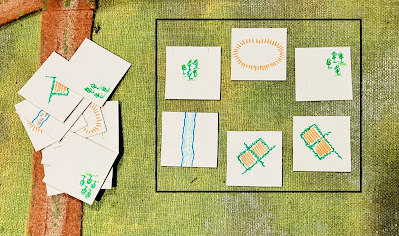 |
| Terrain cards are used to determine the tabletop layout. |
 |
| The tabletop is setup and armies deployed. |
The pre-battle actions had influenced the make up of the chance cards for each army. The Royalists having one extra rally card, while the Parliamentarians force had replaced a confusion card with a panic card. See the previous post for details about the cards.
 |
| Chance cards for the Royalists. One card is drawn and actioned at the start of the Royalist player’s turn. |
 |
| Parliament’s chance cards. The cards are just cut out from a sheet of cardboard from the local craft store. |
Order of Battle
- 4 x Cavalry
- 3 x Infantry
- 1 x Artillery
- 2 x Dragoons
- 3 x Cavalry
- 4 x Infantry
- 1 x Artillery
- 2 x Dragoons
Opening moves along the river
The Royalist forces, led by Sir Charles Blackthorne, began by advancing on their right flank beside the river, committing both their cavalry and dragoons to the attack. In response, Sir Nathaniel Cleve, commanding the Parliamentarian army, countered by pushing forward his left flank cavalry and advancing his infantry in the centre where he had an advantage in numbers.
After an intense struggle, the Parliamentarian cavalry gained the upper hand, routing their Royalist counterparts. However, their success was short-lived as they were caught in a withering volley from the nearby Royalist dragoons and scattered in disorder.
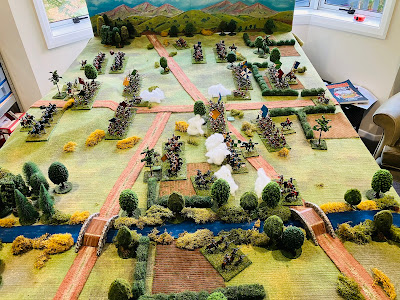 |
| The opening action was along river. |
 |
| Parliament’s first success with their cavalry was short-lived as their cavalry, disorganised after the clash with Royalist cavalry, were scattered by accurate musketry from dragoons. |
The centres clash
Sir Nathaniel Cleve continued to advance his centre, pushing the leading infantry line forward while repositioning his second line to cover the gap left by the routed cavalry near the river. Both centres engaged in a short exchange of musketry before running out of ammunition. Meanwhile, Parliament’s right-wing cavalry began a cautious advance.
Fortune favoured the Royalists. Their centre-right successfully broke the opposing Parliamentarian infantry after a panic in the ranks, leaving Cleve’s left flank dangerously exposed. Sensing an opportunity, the Royalists committed their reserve cavalry, moving them up on the right to exploit the situation.
Meanwhile, on the opposite flank, the cavalry of both sides were locked in a fierce struggle with neither side able to gain the upper hand.
 |
| The infantry centres advance. |
 |
| Royalist reserve cavalry move along the river as Parliament reposition their second line of infantry. |
The flanks
 |
| A hard fought cavalry action on the other flank sees the Royalists about to prevail. |
 |
| Cavalry threaten both flanks of Parliaments centre, forcing them to retire. |
Wrap up…
OHW Rules Variations
I used a variation of the One-Hour Wargames (OHW) rules for this game. Some of the changes include:
Dragoons and artillery are represented by single bases and are eliminated after taking 8 or more hits, half the threshold of the two base infantry and cavalry units, which are removed after 15 hits.
Dragoons and artillery musket fire uses a D6-2 and must test for running out of ammunition.
All shooting units test for Out of Ammunition. Instead of rolling a separate D6 to test for out of ammunition, I check their shooting roll. If a 5 or 6 is rolled, the unit is considered out of ammunition. (Trotter cavalry cannot be resupplied with ammunition if the resupply chance cards is drawn.)
Movement is subject to friction. At the start of the movement phase, a die is rolled. On a result of 1, the movement phase ends immediately for that side. Units can still shoot.
Armies have 1 to 3 commanders assigned to the centre and wings, as well as a general. Each is attached to an infantry or cavalry unit and they have benefits in hand-to-hand combat.
In hand-to-hand combat, a unit with an attached commander rolls two dice and selects the higher result. If a double is rolled, the commander is wounded or killed and removed from play; the unit then reverts to rolling a single die in future combat.
All musketry and charge moves are limited to a range/distance of 6 inches.
Next up
 |
| Preparing for a sci-fi game. |
